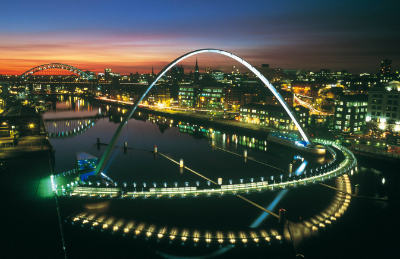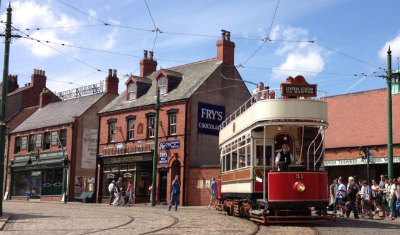Tyne Bridge |
|
 |
Tyne Bridge,The Tyne Bridge is a through arch bridge over the River Tyne in North East England, linking Newcastle upon Tyne and Gateshead. The Bridge was designed by the engineering firm Mott, Hay and Anderson, who later designed the Forth Road Bridge, and was built by Dorman Long and Co. of Middlesbrough. The bridge was officially operated on 10 October 1928 by King George V and has since become a defining symbol of Tyneside. It is ranked as the tenth tallest structure in the city. |
Newcastle UnitedFootball Club (NUFC) |
|
| NUFC is an English professional association football clubbased in Newcastle upon Tyne, which currently plays in the Premier League, thetop tier of English football. It was founded in 1892 by the merger of theNewcastle East End and Newcastle West End, and has played at its current homeground, St James’ Park, ever since. The ground was developed into an all-seaterstadium in the mid-1990s and now has a capacity of 52,353. They have won fourLeague Championship titles, six FA Cups and a Charity Shield, as well as the1969 Inter-Cities Fairs Cup and the 2006 UEFA Intertoto Cup. |  |
SAGE Gateshead |
|
 |
The Sage Gateshead is a concert venue and also a centre for musical education, located in Gateshead on the south bank of the River Tyne, in the North East of England. It opened in 2004 and is tenanted by the North Music Trust. The venue is part of the Gateshead Quays development, which also includes the BALTIC Centre for Contemporary Art and the Gateshead Millennium Bridge. Sage Gateshead is the home of Royal Northern Sinfonia, hosts concerts from a wide range of internationally famous artists, and those who have played at the venue include Above and Beyond, Blondie, James Brown, Bonobo, Andy Cutting, De La Soul, Nick Cave, George Clinton, Bill Callahan, Crosby, and others. |
Millennium Bridge |
|
| The Millennium Bridge is a pedestrian and cyclist tilt bridge spanning the River Tyne in England between Gateshead's Quays arts quarter on the south bank, and the Quayside of Newcastle upon Tyne on the north bank. Opened for public use in 2001, the award-winning structure was conceived and designed by architect WilkinsonEyre and structural engineer Gifford. The bridge is sometimes referred to as the 'Blinking Eye Bridge' or the 'Winking Eye Bridge' due to its shape and its tilting method. |  |
Beamish Museum |
|
 |
Beamish, the North of England Open Air Museum is an open-air museum located at Beamish, near the town of Stanley, County Durham, England. The museum's guiding principle is to preserve an example of everyday life in urban and rural North East England at the climax of industrialisation in the early 20th century. Much of the restoration and interpretation is specific to the late Victorian and Edwardian eras, together with portions of countryside under the influence of industrial revolution in 1825. On its 350 acres (140 ha) estate it utilises a mixture of translocated, original and replica buildings; a huge collection of artifacts, working vehicles and equipment; as well as livestock and costumed interpreters. |
Local Information
Newcastle upon Tyne – or ‘Newcastle’ as it is most commonly referred to – is one of the most iconic cities situated in the North East of England, famous for its industrial heritage, eponymous brown ale, popular nightlife as well as distinct regional ‘Geordie’ dialect. The city history dates back about 2,000 year (since AD120) when the Romans built the first bridge to cross the River Tyne. This city is originally known as its Roman name Pons Aelius during the period that under the control of Romans – the Saxons and the Danes amongst others, the name Newcastle has been used since the Norman conquest of England.
· Newcastle Information· Local Tourism
For local transport and taxi service in Newcastle upon Tyne the following website may be useful.
· ABC Taxis, Tel: 0191 232 3636, Web: http://www.abctaxisnewcastle.co.uk/
· Blueline Taxis, Tel: 0191 262 6666, Web: http://www.bluelinetaxis.com/
City Map
You can download the city map from hereFurther Travel Information
Newcastle is served by good rail and road links with easy access from:
· Newcastle International Airport (20 mins by taxis)· DurhamTees Valley Airport (50 mins by taxis)

